Potřebujeme váš souhlas k využití jednotlivých dat, aby se vám mimo jiné mohly ukazovat informace týkající se vašich zájmů. Souhlas udělíte kliknutím na tlačítko „OK“.
ASTM D2304-10
Standard Test Method for Thermal Endurance of Rigid Electrical Insulating Materials
Automaticky přeložený název:
Standardní zkušební metoda pro tepelnou odolnost tuhých elektrických izolačních materiálů
NORMA vydána dne 1.10.2010
Informace o normě:
Označení normy: ASTM D2304-10
Poznámka: NEPLATNÁ
Datum vydání normy: 1.10.2010
Kód zboží: NS-19975
Počet stran: 7
Přibližná hmotnost: 21 g (0.05 liber)
Země: Americká technická norma
Kategorie: Technické normy ASTM
Kategorie - podobné normy:
Anotace textu normy ASTM D2304-10 :
Keywords:
a-c breakdown voltage, flexural strength, heat aging, rigid plates, rigid sheets, thermal endurance, thermosetting laminates, water absorption, Electrical field strength, Electrical insulating plastics, Electrical insulating solids, Flexural testing--electrical insulating materials, Ovens, Thermal analysis (TA)--electrical insulation, Water absorption--electrical insulating materials, ICS Number Code 29.035.01 (Insulating materials in general)
Doplňující informace
| Significance and Use | ||||||||||||
|
Thermal degradation is often a major factor affecting the life of insulating materials and the equipment in which they are used. The temperature index provides a means for comparing the thermal capability of different materials in respect to the degradation of a selected property (the aging criterion). This property needs to directly or indirectly represent functional needs in application. For example, it is possible that a change in dielectric strength will be of direct, functional importance. However, more often it is possible that a decrease in dielectric strength will indirectly indicate the development of undesirable cracking (embrittlement). A decrease in flexural strength has the potential to be of direct importance in some applications, but also has the potential to indirectly indicate a susceptibility to failure in vibration. Often, it is necessary that two or more criteria of failure be used; for example, dielectric strength and flexural strength. Other factors, such as vibration, moisture and contaminants, have the potential to cause failure after thermal degradation takes place. In this test method, water absorption provides one means to evaluate such considerations. For some applications, the aging criteria in this test method will not be the most suitable. Other criteria, such as elongation at tensile or flexural failure, or resistivity after exposure to high humidity or weight loss, have the potential to serve better. The procedures in this test method have the potential to be used with such aging criteria. It is important to consider both the nature of the material and its application. For example, it is possible that tensile strength will be a poor choice for glass-fiber reinforced laminates, because it is possible that the glass fiber will maintain the tensile strength even when the associated resin is badly deteriorated. In this case, flexural strength is a better criterion of thermal aging. When dictated by the needs of the application, it is possible that an aging atmosphere other than air will be needed and used. For example, thermal aging can be conducted in an oxygen-free, nitrogen atmosphere. |
||||||||||||
| 1. Scope | ||||||||||||
|
1.1 This test method provides procedures for evaluating the thermal endurance of rigid electrical insulating materials. Dielectric strength, flexural strength, or water absorption are determined at room temperature after aging for increasing periods of time in air at selected-elevated temperatures. A thermal-endurance graph is plotted using a selected end point at each aging temperature. A means is described for determining a temperature index by extrapolation of the thermal endurance graph to a selected time. 1.2 This test method is most applicable to rigid electrical insulation such as supports, spacers, voltage barriers, coil forms, terminal boards, circuit boards and enclosures for many types of application where retention of the selected property after heat aging is important. 1.3 When dielectric strength is used as the aging criterion, it is also acceptable to use this test method for some thin sheet (flexible) materials, which become rigid with thermal aging, but is not intended to replace Test Method D1830 for those materials which must retain a degree of flexibility in use. 1.4 This test method is not applicable to ceramics, glass, or similar inorganic materials. 1.5 The values stated in metric units are to be regarded as standard. Other units (in parentheses) are provided for information. 1.6 This standard does not purport to address all of the safety concerns, if any, associated with its use. It is the responsibility of the user of this standard to establish appropriate safety and health practices and determine the applicability of regulatory limitations prior to use. A specific warning statement is given in 10.3.4. |
||||||||||||
| 2. Referenced Documents | ||||||||||||
|
Podobné normy:
Historická
1.1.2012
Historická
1.11.2013
Historická
1.10.2009
Historická
1.5.2010
Historická
15.5.2014
Historická
1.2.2013


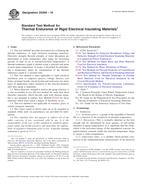
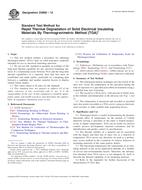 ASTM D3850-12
ASTM D3850-12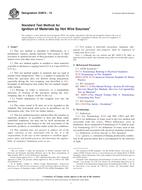 ASTM D3874-13
ASTM D3874-13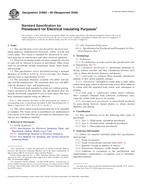 ASTM D4063-99(2009)..
ASTM D4063-99(2009)..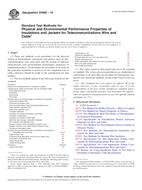 ASTM D4565-10
ASTM D4565-10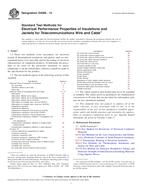 ASTM D4566-14
ASTM D4566-14 ASTM D470-13
ASTM D470-13
 Cookies
Cookies
